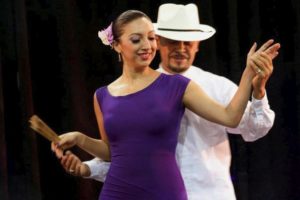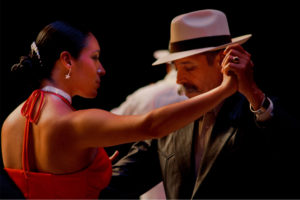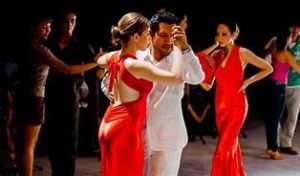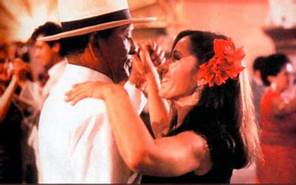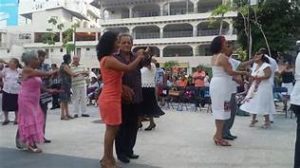LA CULTURA CUBANA es una combinación de tradiciones españolas y africanas. La mezcla de la guitarra española y del tambor africano da la música cubana sus formas más distintivas, la rumba y el son. No obstante algunos de los ritmos folclóricos (como el punto, el zapateo y la guajira) tienen una influencia de la música Europa. Otras canciones y danzas famosas son> la guaracha, el bolero, la habanera, el mambo y el danzón.
Coloquemos el viejo género del danzón en Matanzas, Cuba: Un hombre con una guayabera blanca se acerca a una mujer y extiende la mano, palma hacia arriba, invitándola a bailar. Se pone de pie y agita su abanico. En la pista de baile, se acercan.
Tal escena a fines del siglo XIX en Cuba fue escandalosa en algunos círculos. También era un nuevo género musical, el danzón.
 VIDEOS- El Danzón entre Parejas…
VIDEOS- El Danzón entre Parejas…
ANIVERSARIO DE UN RITMO QUE HA DURADO….
Este año se cumplió el aniversario 143 del nacimiento público de una gloria musical cubana, hoy devenido internacional, “el Danzón”. El primero de enero de 1879 se reconoce como estreno del primer danzón “Alturas de Simpson” en el Liceo de su Matanzas compuesto por el músico Miguel Failde Pérez (1852-1921).
Miguel Failde tuvo como primer maestro a su padre, descubridor de sus aptitudes para la música. A la temprana edad de 12 años dominó el cornetín y al morir su padre estudió, gracias a su hermano mayor con Federico Peclier, profesor del Conservatorio de París.
Dirigió la Banda de Bomberos de su natal Matanzas y años más tarde formó su propia banda musical, en 1871, la orquesta que bautizó con su propio nombre y con la cual tocó por 50 años gozando de la popularidad.
Un testimonio del propio autor nos revela: “Fue aquí, en Matanzas, donde cerca de 40 años se tocó y bailó, bajo mi dirección y por primera vez, el danzón. Despúes yo mismo lo llevé a La Habana y lo toqué y se bailó allí por primera vez también en una reunión familiar donde se hallaba el célebre profesor Raimundo Valenzuela (1848.1905), quien lo aplaudió y aceptó como baile típico cubano”.
 VIDEOS- El Danzón bailado en Mexico…
VIDEOS- El Danzón bailado en Mexico…
EL DANZON COMO PATRIMONIO NACIONAL CUBANO…
El danzón, parte del patrimonio musical intangible de la nación cubana encontró espacios en Latinoamérica, con lo cual se internacionaliza.
Danzón, danza y música surgida en la década de 1920 en Cuba, que traspasó las fronteras y llegó de México y Centroamérica. Procede de la contradanza y del cinquillo. Se interpreta en compás es de 2/4 y se baila en parejas, donde como el tango, el hombre imprime la fuerza y la mujer realiza las florituras. A semejanza del chotis, se baila sobre un espacio reducido, es decir, que no hay grandes desplazamientos.
La música del danzón es, en muchas ocasiones, una adaptación, de las canciones populares y, a veces, incluso, fragmentos de música clásica. Ello significa que no tienen una melodía propia, sino que son los arreglos orquestales los que imprimen la cadencia al baile.
AUTORES
Autores notables han sido:
Miguel Faílde
Manuel Samuell
Raimundo Valenzuela
Tomás Ponce
Agustín Lara
Entre algunos de los intérpretes más conocidos están:
Barbarito Diez
La orquesta Belisario López
Arcaño y sus Maravillas
Acerina y su danzonera
Toña la Negra.
Esta danza ha alcanzado gran popularidad en todo el mundo gracias a la película ‘Danzón’ (1991) de la directora mexicana María Novaro.
Agustín Lara compuso cerca de 500 canciones y cultivo y gran número de géneros musicales, desde el vals hasta el danzón, aunque siempre sintió predilección por el bolero.
El danzón pertenece a la familia de la rumba, el mismo está compuesto por instrumentos como: dos flautas, dos cornetines, dos clarinetes, contrabajo, las pailas, el guiro, entre otos.
En el siglo XIX, compositores con formación musical clásica crearon en Cuba y Puerto Rico formas locales propias de música clásica ligera, como, por ejemplo, la contradanza cubana (también conocida como habanera), el danzón, estilo cubano más ligero y rítmico, y la danza, estilo de Puerto Rico similar al anterior. A principios del siglo XX, surgieron varios compositores clásicos famosos, como Ernesto Lecuona, Alejandro García Caturla y Amadeo Roldán.
El Danzón es considerado el baile nacional de los cubanos, aunque otros ritmos tan auténticos como él pueden disputarle la supremacía. Pero el Danzón, aunque opacada por nuevas creaciones musicales, siempre sera parte del patrimonio musical intangible de la nación cubana.
TODAY THE DANCED DANZON OCCUPIES, FOR 143 YEARS, AN IMPORTANT PLACE AMONG LOVERS. PHOTOS.
Cuban culture is a combination of Spanish and African traditions. The mixture of the Spanish guitar and the African drum gives Cuban music its most distinctive forms, the rumba, and the son. However, some of the folk rhythms (such as the point, the zapateo, and the guajira) have an influence from European music. Other famous songs and dances are> the guaracha, the bolero, the habanera, the mambo, and the danzón.
Let’s place the old danzón genre in Matanzas, Cuba: A man in a white guayabera approaches a woman and extends her hand, palm up, inviting her to dance. He stands up and waves her fan. On the dance floor, they get closer.
Such a scene in late 19th century Cuba was scandalous in some circles. It was also a new musical genre, the danzón.
 VIDEOS- The Traditional Cuban Danzón ..
VIDEOS- The Traditional Cuban Danzón ..
ANNIVERSARY OF A RHYTHM THAT HAS LASTED…
This year marked the 143rd anniversary of the public birth of a Cuban musical glory, now international, “el Danzón”. The first of January 1879 is recognized as the premiere of the first danzón “Alturas de Simpson” at the Liceo de su Matanzas, composed by the musician Miguel Failde Pérez (1852-1921).
Miguel Failde had his father as his first teacher, discoverer of his aptitude for music. At the early age of 12, he mastered the cornet and when his father died he studied, thanks to his older brother, with Federico Peclier, a professor at the Paris Conservatory.
He directed the Firefighters Band of his native Matanzas and years later he formed his own musical band, in 1871, the orchestra that he baptized with his own name and with which he played for 50 years enjoying popularity.
A testimony of the author himself reveals to us: “It was here, in Matanzas, where for nearly 40 years the danzón was played and danced, under my direction and for the first time. Later I took it to Havana myself and played it and it was danced there for the first time also at a family reunion where the famous teacher Raimundo Valenzuela (1848-1905) was present, who applauded it and accepted it as a typical Cuban dance”.
THE DANZON AS CUBAN NATIONAL HERITAGE…
The danzón, part of the intangible musical heritage of the Cuban nation, found spaces in Latin America, with which it is internationalized.
Danzón, dance, and music that emerged in the 1920s in Cuba, which crossed borders and came from Mexico and Central America. It comes from the contradanza and the cinquillo. It is performed in 2/4 time and is danced in pairs, where, like the tango, the man prints strength and the woman performs the flourishes. Like the chotis, it is danced on a small space, that is, there are no large displacements.
The music of the danzón is, on many occasions, an adaptation of popular songs and, sometimes, even fragments of classical music. This means that they do not have their own melody, but rather it is the orchestral arrangements that imprint the cadence of the dance.
AUTHORS
Notable authors have been:
Miguel Failde
Manuel Samuel
Raymond Valenzuela
Thomas Ponce
Agustin Lara
Among some of the best-known performers are:
Barbarito Ten
The Belisario Lopez Orchestra
Arcanum and its Wonders
Acerina and her danzonera
Black Tona.
This dance has become very popular all over the world thanks to the film ‘Danzón’ (1991) by the Mexican director María Novaro.
Agustín Lara composed close to 500 songs and cultivated a large number of musical genres, from the waltz to the danzón, although he always had a predilection for the bolero.
The danzón belongs to the rumba family, it is made up of instruments such as two flutes, two cornets, two clarinets, double bass, the pailas, the guiro, among others.
In the 19th century, composers with classical musical training created their own local forms of light classical music in Cuba and Puerto Rico, such as the Cuban contradanza (also known as habanera), the danzón, a lighter and more rhythmic Cuban style, and the dance, style of Puerto Rico similar to the previous one. At the beginning of the 20th century, several famous classical composers emerged, such as Ernesto Lecuona, Alejandro García Caturla, and Amadeo Roldán.
The Danzón is considered the national dance of Cubans, although other rhythms as authentic as it can dispute its supremacy. But the Danzón, although overshadowed by new musical creations, will always be part of the intangible musical heritage of the Cuban nation.
Agencies/ Wiki/ RHC/ Guadalupe Yaujar/ Extractos/ Excerpts/ Internet Photos/ Arnoldo Varona/ www.TheCubanHistory.com
THE CUBAN HISTORY, HOLLYWOOD.



 OCUPA hoy el Danzón bailado, por 143 años, un Importante Lugar entre los Enamorados. VIDEOS. * TODAY the Danced DANZÓN occupies, for 143 years, an Important Place among Lovers. PHOTOS /VIDEOS.
OCUPA hoy el Danzón bailado, por 143 años, un Importante Lugar entre los Enamorados. VIDEOS. * TODAY the Danced DANZÓN occupies, for 143 years, an Important Place among Lovers. PHOTOS /VIDEOS.